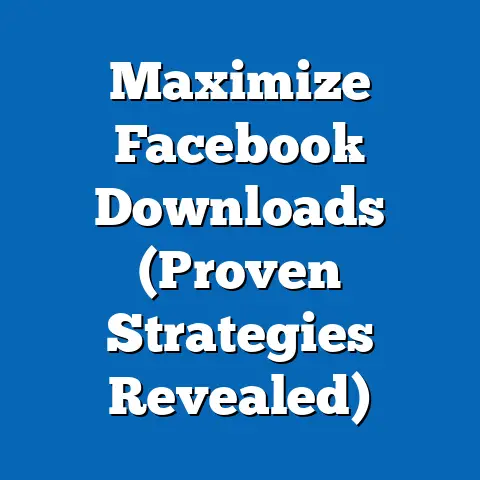Maximize Available Balance for Facebook Ads (Pro Tips)
In today’s fiercely competitive digital landscape, every marketing dollar counts. As a digital marketing expert, I’ve seen firsthand how businesses can thrive or falter based on their ability to manage their advertising budgets effectively. That’s why I’m passionate about helping businesses understand how to maximize their available balance in Facebook Ads. It’s not just about saving money; it’s about building a sustainable digital marketing strategy that drives long-term growth.
Think of your available balance as the fuel in your marketing engine. If you’re burning through it without a clear destination or a well-maintained engine, you’re wasting precious resources. But when you strategically manage that fuel, optimize your campaigns, and target the right audience, you can achieve remarkable results.
Understanding Available Balance in Facebook Ads
Before we dive into the strategies, it’s crucial to understand what “available balance” actually means in the context of Facebook Ads. Simply put, your available balance is the amount of money you have allocated and can spend on your ad campaigns. It’s the difference between your total budget and the amount you’ve already spent.
Types of Budgets and Their Impact:
Facebook offers different types of budgets, each with its own implications for your available balance:
- Daily Budget: This is the average amount you’re willing to spend on a campaign each day. Facebook might spend slightly more or less on any given day, but over the course of a week, it will aim to stay within your daily budget multiplied by the number of days.
- Lifetime Budget: This is the total amount you’re willing to spend on a campaign over its entire duration. Facebook will optimize your ad delivery to get the best results within that budget.
Your choice of budget type directly affects how your available balance is managed. With a daily budget, you’ll see your available balance decrease gradually each day. With a lifetime budget, you’ll have a larger pool of funds to work with, but it’s essential to monitor your spending closely to avoid running out of budget prematurely.
Ad Bidding and Its Effect:
Ad bidding is another critical factor that influences your available balance. When you create an ad, you’re essentially bidding against other advertisers for the opportunity to show your ad to a specific audience. Facebook uses an auction system to determine which ads get shown and at what price.
You can choose between two primary bidding strategies:
- Manual Bidding: You set the maximum amount you’re willing to pay for each click, impression, or conversion. This gives you more control over your spending, but it requires careful monitoring and adjustments to stay competitive.
- Automatic Bidding: Facebook automatically sets your bids based on your campaign goals and budget. This is a simpler option, but it can sometimes lead to higher costs if not managed properly.
Understanding how these factors interact is crucial for effectively managing your available balance and ensuring that your ad spend is aligned with your marketing objectives.
Key Takeaway: Your available balance is the lifeblood of your Facebook Ads campaigns. By understanding how different budget types and bidding strategies affect your spending, you can start to make more informed decisions and optimize your campaigns for maximum impact.
Setting Up a Strategic Budget
Now that you have a solid understanding of the basics, let’s move on to the practical steps of setting up a strategic budget that maximizes your available balance. This involves careful planning, data analysis, and the use of Facebook’s built-in tools.
Step 1: Determine Your Advertising Goals
The first step is to clearly define your advertising goals. What do you want to achieve with your Facebook Ads campaigns? Are you looking to increase brand awareness, generate leads, drive sales, or something else entirely?
Your goals will directly influence your budget allocation. For example, if you’re focused on brand awareness, you might allocate more budget to reach a wider audience with engaging content. If you’re focused on lead generation, you might prioritize campaigns that drive traffic to landing pages with lead capture forms.
Step 2: Analyze Past Performance Data
Before setting your budget, it’s essential to analyze your past performance data. What has worked well in the past? What hasn’t? Which campaigns have generated the best ROI?
Facebook Ads Manager provides a wealth of data that can help you make informed budget decisions. Take a close look at metrics like:
- Cost Per Click (CPC): How much are you paying for each click on your ads?
- Click-Through Rate (CTR): What percentage of people who see your ad are clicking on it?
- Conversion Rate: What percentage of people who click on your ad are completing a desired action, such as making a purchase or filling out a form?
- Cost Per Acquisition (CPA): How much are you paying to acquire a new customer?
By analyzing this data, you can identify your most effective campaigns and allocate more budget to them. You can also identify underperforming campaigns and either optimize them or pause them to avoid wasting money.
Step 3: Utilize Facebook’s Budget Optimization Tools and Insights
Facebook offers several budget optimization tools and insights that can help you forecast spending effectively. One of the most useful is the “Estimated Daily Results” feature, which provides an estimate of the number of people you can reach and the number of clicks you can expect based on your budget and targeting settings.
You can also use Facebook’s “Campaign Budget Optimization” (CBO) feature, which automatically distributes your budget across your ad sets to get the best overall results. With CBO, you simply set a budget at the campaign level, and Facebook will optimize your ad delivery to maximize conversions or other desired outcomes.
Key Takeaway: Setting up a strategic budget is an iterative process that requires careful planning, data analysis, and the use of Facebook’s optimization tools. By aligning your budget with your business objectives and customer lifetime value, you can create a sustainable digital marketing strategy that drives long-term growth.
Utilizing Audience Targeting to Maximize Spend
Audience targeting is arguably the most critical factor in maximizing your available balance. If you’re showing your ads to the wrong people, you’re wasting money, plain and simple. Facebook offers a wide range of targeting options that allow you to reach the most relevant audiences for your products or services.
Facebook’s Targeting Options:
- Demographics: You can target people based on their age, gender, education, relationship status, and other demographic factors.
- Interests: You can target people based on their interests, hobbies, and passions. Facebook gathers this information from the pages people like, the groups they join, and the content they engage with.
- Behaviors: You can target people based on their online and offline behaviors, such as their purchase history, travel habits, and device usage.
- Custom Audiences: You can create custom audiences based on your own data, such as your email list, website visitors, or app users.
- Lookalike Audiences: You can create lookalike audiences based on your existing custom audiences. Facebook will find people who share similar characteristics and behaviors with your best customers.
Creating Highly Targeted Ad Sets:
To maximize your available balance, it’s essential to create highly targeted ad sets that focus on the most relevant audiences. Avoid casting too wide a net, as this can lead to wasted ad spend and lower conversion rates.
Instead, try to narrow down your target audience as much as possible. For example, if you’re selling running shoes, you might target people who are interested in running, fitness, and outdoor activities. You could also target people who have recently purchased running shoes or visited your website.
A/B Testing Different Audience Segments:
A/B testing different audience segments is crucial for determining the most effective targeting strategies. Create multiple ad sets with different targeting settings and run them simultaneously. Then, track the performance of each ad set to see which ones are generating the best results.
Pay close attention to metrics like CPC, CTR, and conversion rate. The ad sets with the lowest CPC and highest CTR and conversion rate are likely the most effective. You can then reallocate your budget to these ad sets and scale up your campaigns.
Key Takeaway: Audience targeting is the key to maximizing your available balance in Facebook Ads. By creating highly targeted ad sets and A/B testing different audience segments, you can ensure that your ad spend is directed at the most relevant audiences, increasing your chances of conversion and driving sustainable growth.
Monitoring and Adjusting Campaigns in Real-Time
Setting up a strategic budget and targeting the right audience are essential steps, but they’re not enough. To truly maximize your available balance, you need to monitor your campaigns in real-time and make adjustments based on performance data.
Key Performance Indicators (KPIs):
Here are some of the key performance indicators (KPIs) that you should track:
- Reach: The number of unique people who saw your ad.
- Impressions: The number of times your ad was displayed.
- Click-Through Rate (CTR): The percentage of people who saw your ad and clicked on it.
- Cost Per Click (CPC): The amount you paid for each click on your ad.
- Conversion Rate: The percentage of people who clicked on your ad and completed a desired action, such as making a purchase or filling out a form.
- Cost Per Acquisition (CPA): The amount you paid to acquire a new customer.
- Return on Ad Spend (ROAS): The revenue you generated for every dollar you spent on advertising.
By tracking these KPIs, you can get a clear picture of how your campaigns are performing and identify areas for improvement.
Adjusting Campaigns Based on Performance Data:
Based on your performance data, you can make several adjustments to your campaigns to maximize your available balance:
- Pausing Underperforming Ads: If an ad is not generating clicks or conversions, pause it immediately to avoid wasting money.
- Reallocating Budget to High-Performing Campaigns: If a campaign is performing well, reallocate more budget to it to scale up your results.
- Refining Ad Creative: If your ads are not generating a high CTR, try refining your ad copy, images, or videos.
- Adjusting Targeting Settings: If your ads are not reaching the right audience, adjust your targeting settings to narrow down your focus.
- Optimizing Bidding Strategies: If you’re using manual bidding, adjust your bids to stay competitive. If you’re using automatic bidding, monitor your costs closely and make adjustments as needed.
Key Takeaway: Real-time monitoring and adjustments are essential for maximizing your available balance in Facebook Ads. By tracking key performance indicators and making data-driven decisions, you can optimize your campaigns for maximum impact and drive sustainable growth.
Leveraging Retargeting Campaigns
Retargeting is a powerful technique that can help you maximize your available balance by focusing on users who have already shown interest in your products or services. These are people who have visited your website, viewed your products, or added items to their cart but haven’t yet completed a purchase.
Setting Up Effective Retargeting Campaigns:
To set up effective retargeting campaigns, you’ll need to use the Facebook Pixel and Custom Audiences. The Facebook Pixel is a small piece of code that you install on your website. It tracks the actions that people take on your site, such as viewing pages, adding items to their cart, and making purchases.
You can then use this data to create Custom Audiences of people who have taken specific actions on your website. For example, you can create a Custom Audience of people who have visited your product pages but haven’t made a purchase.
Creating Compelling Retargeting Ads:
Once you’ve created your Custom Audiences, you can create compelling retargeting ads that encourage conversions. These ads should be tailored to the specific actions that people have taken on your website.
For example, if someone has added items to their cart but hasn’t completed a purchase, you might show them an ad that reminds them of the items they left behind and offers them a discount to encourage them to complete their purchase.
Balancing Retargeting with New Audience Acquisition:
While retargeting is a powerful technique, it’s essential to balance it with new audience acquisition. You don’t want to rely solely on retargeting, as this can limit your growth potential.
Instead, you should use retargeting to supplement your new audience acquisition efforts. This will allow you to maximize your available balance while still reaching new customers and expanding your business.
Key Takeaway: Retargeting is a powerful technique that can help you maximize your available balance by focusing on users who have already shown interest in your products or services. By setting up effective retargeting campaigns and creating compelling retargeting ads, you can drive conversions and increase your ROI.
Conclusion
Maximizing your available balance in Facebook Ads is not just about saving money; it’s about building a sustainable digital marketing strategy that drives long-term growth. By understanding the basics of budget management, setting up a strategic budget, utilizing advanced targeting techniques, monitoring your campaigns in real-time, and leveraging retargeting campaigns, you can make every dollar count and achieve remarkable results.
Sustainable digital marketing not only involves budget management but also strategic planning, ongoing adjustments, and leveraging advanced targeting techniques. It’s a continuous process of learning, testing, and optimizing.
As you continue to adapt and evolve your Facebook advertising strategies, remember to stay focused on your goals, track your performance, and make data-driven decisions. By doing so, you can achieve long-term success while maintaining a commitment to sustainability in your marketing practices.
The digital landscape is constantly changing, but the principles of effective budget management and strategic planning remain the same. By following the tips and strategies outlined in this guide, you can maximize your available balance, drive sustainable growth, and achieve your marketing goals.





